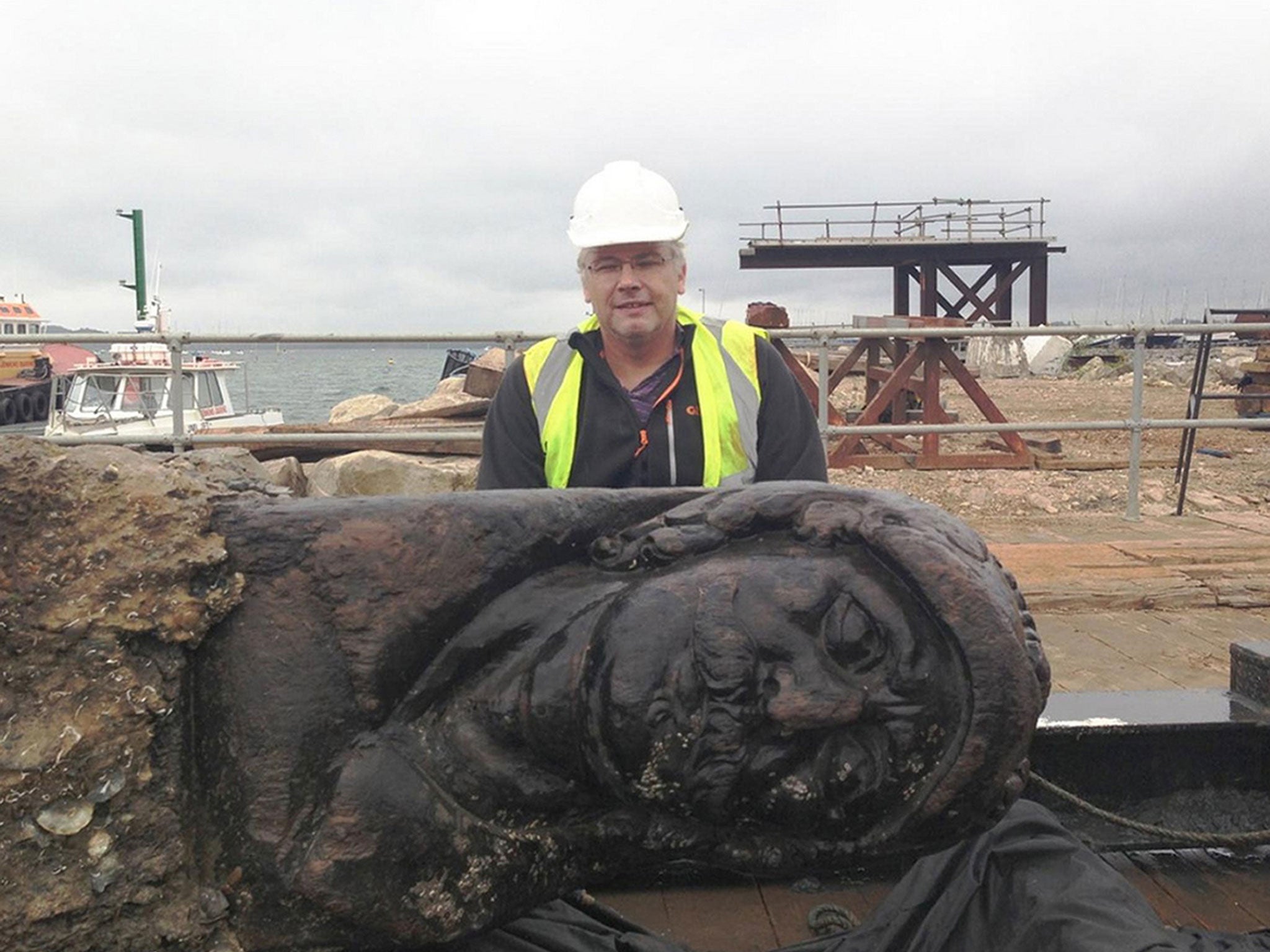Poole wreck: Wooden head raised from seabed heightens 17th-century mystery
Large sculpted moustachioed human head formed part of the wrecked ship’s 3.5 tonne rudder

A unique work of art raised yesterday from the seabed off the Dorset coast is, for the time being at least, proving as mysterious as the wrecked 17th century vessel it came from.
The wooden masterpiece – a large sculpted moustachioed human face – formed part of the sunken ship’s eight metre long 3.5 tonne rudder. But who the three-times-life-size sculpture represents – and even the identity of the vessel itself is currently unknown.
Research, carried out on behalf of Bournemouth University’s Marine Archaeology Research Group, suggests that the ship was built in Holland in 1628 or 1629 and that it sank sometime between 1630 and 1645. But the huge size of the rudder and its sculpted face could ultimately prove crucial in more accurately working out the vessel’s size and likely port of origin.
However, perhaps the biggest mystery of all is why it ended up at the bottom of the sea off Dorset. At least five options are being examined by the researchers. They include the possibility that she was sunk in the English Civil War (the Dutch were involved in arms running to both sides!) or that she was attacked by Spanish-backed privateers or even Algerian pirates. Alternatively she could have run aground on a sandbank or been wrecked in a storm.
The great wooden rudder (including its moustachioed sculpture) is the final artefact being brought up from the wreck site. For over the past seven years, some 1200 finds have been rescued from the wreck by Bournemouth University marine archaeologists. The site has now been sealed to prevent erosion and looting. The material lifted from the seabed by the archaeologists has included ship’s timbers, elaborate wooden carvings, ropes and pulley blocks from the rigging, several cannon and gun carriages, cannon balls, lanterns, navigational equipment, shoes, boots, cooking utensils – and even the large barrels which had once contained the ship’s store of salt beef.
The sculpted moustachioed rudder head lifted from the seabed yesterday is a unique artefact. No other example is known from anywhere else in the world.
Some of the objects will go on exhibition in Poole Museum next year, although a more complete selection – including much of the vessel’s bow castle and the great rudder – will probably go on permanent display in 2015 or 2016. Most of the material is currently undergoing conservation, funded by English Heritage and the Heritage Lottery Fund, at York Archaeological Trust in York.
A potentially insoluble mystery is what the vessel was carrying. No cargo has been found – so it is conceivable that it was officially salvaged in the 17 century – or alternatively that it was illegally looted by people in the Poole area before the authorities could reach it.
The wreck is located near Poole – a mile off the coast in some seven metres of water. It was first discovered in 1990 when a dredger hit an obstruction. Detailed archaeological work on the site, known as the Swash Channel, started in 2006. It’s been one of the largest marine archaeological projects ever carried out in UK waters – involving dozens of Bournemouth University archaeology students and staff over the past seven years.
“The wreck is important because so much of it survives”, said Bournemouth University marine archaeologist, Dave Parham. “It is the ship itself that is significant – there are only a few wrecks like this in the world, and it tells us more about the beginnings of large scale international trade,” he added.
It’s currently estimated that the substantial vessel was around 40 metres in length and designed for ocean-going trade. Around 40 per cent of the ship is intact under the seabed – and some 4 per cent has been raised. The underwater excavations, funded by English Heritage, were necessary to protect key elements of the historic vessel from erosion.
Join our commenting forum
Join thought-provoking conversations, follow other Independent readers and see their replies
Comments